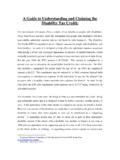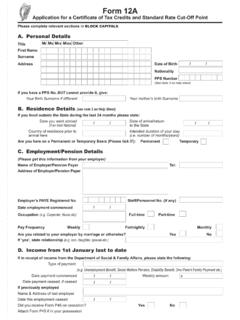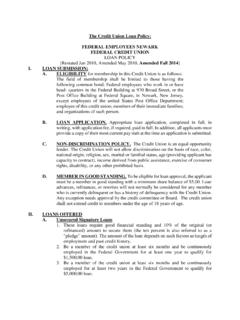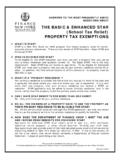Transcription of A Guide to Understanding and Claiming the …
1 A Guide to Understanding and Claiming the disability Tax Credit: The Government of Canada offers a variety of tax benefits to people with disabilities. These benefits are provided under the assumption that people with disabilities will have unavoidable, additional expenses that are not faced by other taxpayers. The disability Tax Credit (DTC) is intended to act as a fairness measure for people with disabilities1 and their families. As such, it is designed to help offset the additional expenses associated with having a severe and prolonged impairment in physical or mental functions, which markedly restricted a person s ability to perform at least one basic activity of daily living.
2 For the year 2010, the DTC amount is $7, This amount is multiplied by a person s tax rate to determine the actual dollar benefit that they will receive. The DTC also includes a supplement for people under the age of 18. In 2010, the supplement amount is $4,223. This supplement may be reduced if, in 2010, someone claimed child care expenses or attendant care expenses for the individual. It may also be reduced if the taxpayer with a disability claims attendant care expenses for himself. In total, for the year 2010, the DTC plus supplement could represent up to $1,7192 being returned to an individual taxpayer. The disability Tax Credit came into being in 1988 as a non-refundable tax credit.
3 Being non-refundable means that it is designed to help to reduce a person s taxable income to zero. If the application of the credit results in a negative tax owing, no refund is issued. However, any amount of the disability tax credit that is not needed by the person with the disability to reduce their taxes payable to zero can be transferred to a supporting person . A supporting person may be able to claim all or part of their dependant's disability amount if the person with a disability was resident in Canada at any time in 2010 and was dependent on the supporting person for some or all of the basic necessities of life (food, shelter, or clothing). A supporting person can be a spouse or common-law 1 Technical Advisory Committee on Tax Measures for Persons With Disabilities, 2 ($ + X 15%) partner, or a parent, grandparent, child, grandchild, brother, sister, aunt, uncle, nephew or niece of the individual.
4 One of the features of the DTC is that if a taxpayer failed to claim it for a particular taxation year, they can back-file for up to 10 years and receive full benefit for each of those years. This can result in substantial amounts of money being received by people with disabilities or by people who have provided support to them. Over the past several years, a number of organizations3 have been created with the stated purpose of assisting individuals in applying for these credits. The implication is that the process is very difficult and should not be attempted by the Canadian public. Some also imply that they have inside information or contacts with Canada Revenue Agency and that without their involvement, people will not be able to access all of the credits available to them.
5 They often entice people into dealing with them by offering Free Consultations . Some of these organizations have been known to charge a fee of up to 30% of any taxes recovered. In real terms, this means that individuals often find themselves paying thousands of dollars for something that they could do on their own for the cost of a postage stamp. In fact, says Canada Revenue Agency s spokesman Philippe Brideau:4 the application process for the disability Tax Credit is not complicated, A person can keep their own money by simply following the application process themselves. However, if people are uncomfortable with completing the process themselves, they could utilize the services of a fully qualified Chartered Accountant and pay a few hundred dollars in fees.
6 The intent of this information package is to demystify the process of determining a person with Cerebral Palsy s eligibility to receive the DTC and to Guide people toward Claiming the full credit that they are entitled to. The expectation is that people will be able to spend a few minutes of their own time to read and follow this document s 3 Listing available via author at 4 The Toronto Star, Print Article 916219 January 5, 2011 instructions to access potentially thousands of dollars that may be available to them from the Government of Canada. Qualifying for the disability Tax Credit: The disability Tax Credit is available to people who have a severe and prolonged physical or mental impairment.
7 Because of that impairment, the individual must be markedly restricted all or substantially all of the time in their ability to perform a basic activity of daily living, or would be markedly restricted were it not for extensive therapy they receive to sustain a vital Under the Canada Revenue Agency s definition6, a prolonged impairment has lasted or is expected to last, for a continuous period of at least 12 months. Markedly Restricted means that all of the time or substantially all of the time a person is unable (or it takes an inordinate amount of time) to perform one or more of the basic activities of daily living even with therapy (other than life-sustaining therapy to support a vital function) and the use of appropriate devices and medication.
8 Canada Revenue Agency has indicated that as a guideline, substantially all of the time means that the restrictions in activity are present 90% of the time or All of this information is reported to Canada Revenue Agency via the T2201 disability Tax Credit Certificate. A person may be eligible for the disability amount if a qualified practitioner certifies on Form T2201 disability Tax Credit Certificate, that you have a prolonged impairment, and that the effects of the impairment are such that one of the following applies: You are blind, even with the use of corrective lenses or medication. You are markedly restricted in any one of the following basic activities of daily living: o speaking; 5 Technical Advisory Committee on Tax Measures for Persons With Disabilities, pg.
9 3 6 CRA Form T2201 E (10) 7 Technical Advisory Committee on Tax Measures for Persons With Disabilities, o hearing; o walking; o elimination (bowel or bladder functions); o feeding; o dressing; or o performing the mental functions necessary for everyday life. You need, and must dedicate a certain amount of time specifically for, life-sustaining therapy to support a vital function. For 2005 and later years-you do not quite meet the criteria for blind or markedly restricted, but the following conditions apply: o because of your impairment, you are significantly restricted in two or more basic activities of daily living, or you are significantly restricted in vision and at least one of the basic activities of daily living, even with appropriate therapy, medication, and devices; o these significant restrictions exist together, all or substantially all the time; and o the cumulative effect of these significant restrictions is equivalent to being markedly restricted in a single basic activity of daily living.
10 The disability Tax Credit Certificate (Form T2201): In order to apply for the disability Tax Credit, information relating to your disability must be reviewed by Canada Revenue Agency. This information is collected on form T2201, disability Tax Credit Certificate which is submitted to CRA. This form can be obtained on line at . In order to assist an individual in determining whether or not they may qualify for the DTC, the T2201 form contains a self-assessment questionnaire. This questionnaire may be useful in helping a person decide on how to proceed with the application. It should also be noted that the disability Tax Credit Certificate is a requirement for participation in the Registered disability Savings Plan.






